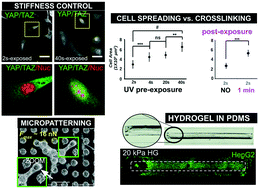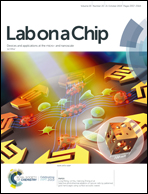Building a microfluidic cell culture platform with stiffness control using Loctite 3525 glue†
Abstract
The study of mechanotransduction signals and cell response to mechanical properties requires designing culture substrates that possess some, or ideally all, of the following characteristics: (1) biological compatibility and adhesive properties, (2) stiffness control or tunability in a dynamic mode, (3) patternability on the microscale and (4) integrability in microfluidic chips. The most common materials used to address cell mechanotransduction are hydrogels, due to their softness. However, they may be impractical when complex scaffolds are sought and they lack viscous dissipative properties that are very important in mechanobiology. In this work, we show that an off-the-shelf, biocompatible photosensitive glue, Loctite 3525, may be used readily in mechanobiology assays without any special treatment prior to fabrication of cell culture platforms. Despite a high (MPa) stiffness easily tunable by UV exposure time at a fixed dose, 3T3 fibroblasts showed a response to the mechanics of the material similar to that obtained on much softer (kPa) hydrogels. Loctite's viscous dissipation properties indeed seemed to be responsible for such cell mechanical response, as suggested by recent works where more complex two-phase hydrogels were employed. More interestingly, it was possible to stiffen soft Loctite substrates by post-exposing them during cell culture, to observe changes in cell spreading caused by a dynamic stiffness modification. Thanks to Loctite 3525's patternability, micropillars were also fabricated to demonstrate the compatibility with traction force microscopy studies. Finally, the glue was used as an excellent adhesion layer for hydrogels on glass or PDMS, without the need for additional treatment, enabling the easy fabrication of microfluidic chips integrating hydrogels.



 Please wait while we load your content...
Please wait while we load your content...